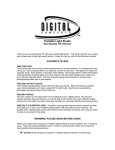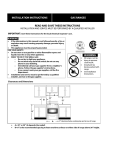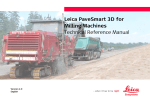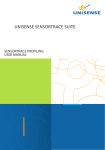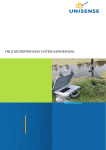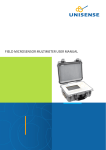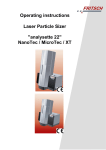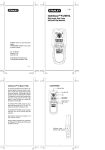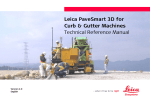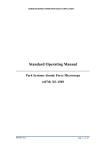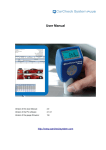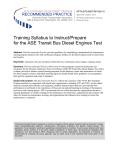Download SensorTrace Photo Manual
Transcript
UNISENSE SENSORTRACE SUITE SENSORTRACE PHOTO USER MANUAL SensorTrace Suite v2.0 User Manual Copyright © 2013 · Unisense A/S Version October 2013 SENSORTRACE PHOTO USER MANUAL UNISENSE A/S TABLE OF CONTENTS SENSORTRACE PHOTO . . . . . . . . . . . . . . . . . . . . . . . . . . . . . . . . . . . . . . . . . . . . . . . . . . . . . . . . . . . . . . . . 1 USER MANUAL . . . . . . . . . . . . . . . . . . . . . . . . . . . . . . . . . . . . . . . . . . . . . . . . . . . . . . . . . . . . . . . . . . . . . . . . 1 CONGRATULATIONS WITH YOUR NEW PRODUCT . . . . . . . . . . . . . . . . . . . . . . . . . . . . . . . . . . . . . . 7 Support, ordering, and contact information 7 WARRANTY AND LIABILITY . . . . . . . . . . . . . . . . . . . . . . . . . . . . . . . . . . . . . . . . . . . . . . . . . . . . . . . . . . . . 8 OVERVIEW . . . . . . . . . . . . . . . . . . . . . . . . . . . . . . . . . . . . . . . . . . . . . . . . . . . . . . . . . . . . . . . . . . . . . . . . . . . . 11 THE LIGHT-DARK SHIFT METHOD . . . . . . . . . . . . . . . . . . . . . . . . . . . . . . . . . . . . . . . . . . . . . . . . . . . . 12 MEASURING SETUP . . . . . . . . . . . . . . . . . . . . . . . . . . . . . . . . . . . . . . . . . . . . . . . . . . . . . . . . . . . . . . . . . . 15 INSTALLING THE SOFTWARE . . . . . . . . . . . . . . . . . . . . . . . . . . . . . . . . . . . . . . . . . . . . . . . . . . . . . . . . 16 GETTING STARTED . . . . . . . . . . . . . . . . . . . . . . . . . . . . . . . . . . . . . . . . . . . . . . . . . . . . . . . . . . . . . . . . . . 17 SENSORTRACE PHOTO INTERFACE . . . . . . . . . . . . . . . . . . . . . . . . . . . . . . . . . . . . . . . . . . . . . . . . . . . 19 SETTINGS TAB . . . . . . . . . . . . . . . . . . . . . . . . . . . . . . . . . . . . . . . . . . . . . . . . . . . . . . . . . . . . . . . . . . . . . . . 20 COMMENTS TAB . . . . . . . . . . . . . . . . . . . . . . . . . . . . . . . . . . . . . . . . . . . . . . . . . . . . . . . . . . . . . . . . . . . . . 22 CALIBRATION TAB . . . . . . . . . . . . . . . . . . . . . . . . . . . . . . . . . . . . . . . . . . . . . . . . . . . . . . . . . . . . . . . . . . . 24 Calibration procedure Recalibration procedure Retrieving a calibration 25 26 26 CALIBRATION OF LIGHT SENSOR . . . . . . . . . . . . . . . . . . . . . . . . . . . . . . . . . . . . . . . . . . . . . . . . . . . . 27 THE LIVE DATA GRAPH . . . . . . . . . . . . . . . . . . . . . . . . . . . . . . . . . . . . . . . . . . . . . . . . . . . . . . . . . . . . . . . 28 EXPERIMENT TAB . . . . . . . . . . . . . . . . . . . . . . . . . . . . . . . . . . . . . . . . . . . . . . . . . . . . . . . . . . . . . . . . . . . . 30 Motor control 32 PERFORMING AN EXPERIMENT . . . . . . . . . . . . . . . . . . . . . . . . . . . . . . . . . . . . . . . . . . . . . . . . . . . . . . 33 Settings Photosynthesis rate measurements The profile windows 33 34 37 OUTPUT FILE . . . . . . . . . . . . . . . . . . . . . . . . . . . . . . . . . . . . . . . . . . . . . . . . . . . . . . . . . . . . . . . . . . . . . . . . 38 EXPERIMENTAL DATA EXAMPLE . . . . . . . . . . . . . . . . . . . . . . . . . . . . . . . . . . . . . . . . . . . . . . . . . . . . . 40 5 6 CONGRATULATIONS WITH YOUR NEW PRODUCT Support, ordering, and contact information If you wish to order additional products or if you encounter any problems and need scientific/technical assistance, please do not hesitate to contact our sales and support team. We will respond to your inquiry within one working day. E-mail: [email protected] Unisense A/S Tueager 1 DK-8200 Aarhus N, Denmark Tel: +45 8944 9500 Fax: +45 8944 9549 Further documentation and support is available at our website www.unisense.com. 7 WARRANTY AND LIABILITY Unisense SensorTrace Suite software is checked and validated on the operating systems as given in the specification, running English language settings. It comes with lifetime updates. Software must be installed under administrator rights. Customer must ensure PC is fully updated and no conflicting third party software is installed. Unisense do not warrant compliance with any other operating systems, language settings or third party software. For instrumentation and sensors, please refer to our warranty conditions as given in the document “General Terms of Sale and Delivery of Unisense A/S” found on www.unisense.com License agreement The following terms shall apply to the software provided by Unisense A/S (“Unisense”) in connection with the simultaneous sale to you (“Customer”) of a Unisense SensorTrace Suite Software. All rights, title and interest in the software belong to Unisense. Unisense grants to the Customer a royalty-free, non-exclusive and non-transferable license to use the software solely in connection with the Unisense Product purchased from Unisense simultaneously with the purchase of the software. The Customer undertakes not to copy, modify, reverse engineer, disassemble or de-compile all or any part of the software or rent, lease, distribute or sell the software. The Customer shall, however, be entitled to make one copy of the software for back-up and recovery purposes for use solely in connection with the Unisense Products supplied by Unisense together with the software. Nothing in this License Agreement or any other agreement between Unisense and the Customer shall be construed as an obligation for Unisense to provide to the Customer updates of the software. This License Agreement shall automatically terminate if the Customer violates the terms of the license. In case of termination of the license the Customer shall immediately destroy the software and any copy thereof. 8 THE CUSTOMER TAKES THE SOFTWARE “AS IS.” UNISENSE MAKES NO WARRANTY OR REPRESENTATION CONCERNING THE SOFTWARE, AND EXPRESSLY DISCLAIMS ALL OTHER WARRANTIES AND CONDITIONS, EXPRESS OR IMPLIED, STATUTORY OR OTHERWISE, OF WHATEVER KIND OR NATURE, INCLUDING BUT NOT LIMITED TO ANY AND ALL IMPLIED WARRANTIES, INCLUDING IMPLIED WARRANTIES OF MERCHANTABILITY AND FITNESS FOR A PARTICULAR PURPOSE. UNISENSE SHALL NOT BE LIABLE FOR ANY DAMAGES OF ANY KIND, INCLUDING INCIDENTAL, SPECIAL, PUNITIVE, CONSEQUENTIAL, AND SIMILAR DAMAGES, INCLUDING, WITHOUT LIMITATION, LOSS OF PRODUCTION, LOSS OF PROFIT, LOSS OF DATA, LOSS OF GOODWILL, LOSS OF CONTRACTS, OR BUSINESS INTERRUPTION This License Agreement and any dispute arising out of or in relation to this License Agreement shall be governed by and construed in accordance with the laws of Denmark exclusive of its choice of law provisions. The venue for any such dispute shall be the Danish courts provided however that Unisense shall be entitled to instigate legal proceedings against the Customer before the courts with jurisdiction over the matter located in a country where the Customer has a place of business or is incorporated or organized. 9 10 OVERVIEW SensorTrace Photo - For photosynthetic experiments using the light-dark switch technique we recommend that you use. SensorTrace Suite is compatible with all digital Unisense instruments. It supports up to 16 channels with an adjustable logging frequency of up to 50 samples per second depending on the Unisense amplifier connected. The program automatically saves all data in an SQL database and all data can be exported in csv formatted files for subsequent data analysis. System requirements: • A digital Unisense amplifier or A/D-converter unit. • PC with Windows XP/2ooo/Vista/Windows 7 32 bit/64, Windows 8/8.1 • min. 200 MB free hard disk space • USB port(s) • min. screen resolution 1280 x 800 • min. 4 GB RAM Other programs available in the full SensorTrace Suite: SensorTrace Profiling - For motor control, activity calculations, and profiling in 1, 2 or 3 dimensions we recommend that you use. SensorTrace Logger is the basic data acquisition program from the Unisense program SensorTrace Suite. It offers timeseries datalogging and calibration features. SensorTrace Rate - For microrespiration experiments to measure the metabolic rates including respiration rates of small aquatic animals, bacteria or oxygen production of phytoplankton we recommend that you use. 11 THE LIGHT-DARK SHIFT METHOD This paragraph gives a short description of the theory on which the light-dark shift method is based. The tip of an oxygen microsensor is placed at a certain position r in a photosynthetic system. It measures at time t the oxygen concentration C(r,t). The time dependency (i.e. the derivative in time) of the oxygen concentration can be described by: ∂C = −T − R + P ∂t where P is the volumetric gross photosynthesis rate of oxygen (mol m-3 s-1) and R the volumetric oxygen respiration rate (mol m-3 s-1), respectively. The volumetric transport rate T represents the changes in oxygen concentration due to transport phenomena (mol m-3 s-1). The type of transport is dependent on the specific sample under investigation. It can be due to advection, convection, or diffusion. The light-dark shift method works for all types of transport. For the light-dark shift technique, it is important that the oxygen concentration reaches a measurable steady state value under a constant illumination setting. At steady state the above equation is equal to zero: ∂C = 0 ⇒ −T − R + P = 0 ∂t If now the illumination is switched off the steady state situation is disturbed. The photosynthesis rate P is now zero, whereas transport and respiration rates are assumed to remain unchanged within the next short time period. Thus, the time dependency of the oxygen concentration C immediately after the onset of darkness is given by: ∂C = −T − R ∂t 12 The latter two equations can be subtracted from each other, which yield: P=− ∂C ∂t Thus, the volumetric gross photosynthesis rate P can be determined by the slope of the oxygen concentration C immediately after the light-dark shift. This is indicated in the following figure. Practically, the measurements are realized by moving the oxygen microsensor tip to the measuring site with the help of a micromanipulator. The sample of interest is illuminated with photosynthetically active light of a constant intensity. Steady state is achieved when the microsensor reading is stable over time. At this point the illumination is switched off. It is essential that the switching event is fast (<<100 ms). Hence, just switching off the light source will usually not work, as most light sources exhibit an afterglow. Normally, sample shading will be the best method. This can be done by either blocking the light path manually (e.g. using a piece of cardboard or aluminium foil) or by applying an electronic shutter. 13 The computer samples the voltage readings of the microsensor at a frequency of 10- 50 Hz. The typical sampling interval starts 1-3 seconds before the switching event and stops 2-4 seconds after it. The time interval before the switching event is used to calculate an average value of the steady state oxygen concentration. The volumetric gross photosynthesis rate is obtained by fitting a linear slope to the data sampled immediately after darkening. The user has to define the start and end time of the fitting interval relative to the switching event. Typical values for the fitting interval are 0-0.5 and 0.5-2 seconds for the start and end times, respectively. As the Photo software has to know exactly when the switching took place, a light sensor is placed within the light field near the measuring site. Its signal is used by the computer as a trigger for the switching event. 14 MEASURING SETUP In order to realize ligh-dark measurement the following components are required for the experimental setup: • Fast responding O2 micro-sensor • Light sensor including amplifier box • Micromanipulator • Microsensor Monometer or Multimeter • Photosynthetic active sample (i.e. algae mat, coral) • Photo software The microsensor is connected via the LEMO connector to a pA channel on the front of the meter, while the UNISENSE Light Sensor box is connected to an analogue input channel at the rear. The UNISENSE Microsensor Mono- or Multimeter is connected to a USB-port of the computer. The microsensor is placed in a micromanipulator that is used to position the sensor tip at the intended measuring site of the studied sample. The tip of the light sensor is positioned, i.e. with a lab stand, within the light field, but placed so that it is not interfering with the path of light towards the measuring site. Thus, the light sensor signal acts as an exact indicator for the time of light to dark transition. 15 INSTALLING THE SOFTWARE Make sure that you are installing having the full administration rights. Start the installation program (.exe file) from the CD. Follow the instructions given by the installation program. This will install the SensorTrace Suite program including a version of this manual in the program group “Unisense”. Instrument drivers and a configuration utility for the A/D-converter will also be installed. This is called Instacal and will be placed in a program group called “Measurement Computing”. To activate the full SensorTrace Suite program and gain access to Logger+, Profiling, Photo, and Rate enter the License Key supplied with the installation CD. To access the dialog box for entering the license key, click on the Enter License Key button in the low right corner for the main SensorTrace Suite window. Press Activate when the key is fully entered. Contact [email protected] to purchase a license key. 16 GETTING STARTED 1. Set the PC power management to Always On. And make sure that your PC does not enter sleep mode or stand by during measurements as this will interrupt the connection to the instruments and it will be necessary to restart the program. 2. Connect all instruments in your set-up to the computer. 3. Start SensorTrace Suite - it is placed in the program group “Unisense”. The following main program window appears: 4. Choose either to make a new Photo experiment or load an old experiment. a. New Experiment: When a new experiment is selected, the user is asked to create a new experiment from the dialog box that appears. Create the new experiment by naming experiment and researcher identitiy, followed by an optional brief experimental description. 17 Finally select an exsisting master experiment or create a new master experiment, then press the Create button to create the new experiment. The master experiment allows the user to group several sub-experiments e.g. on the same sample or sample station. b. Load Experiment: A dialog box appears were you can choose the experiment that you would like to open. Press Load when the experiment is selected. This mode is for working with old data; settings and parameters cannot be changed, and new measurements cannot be started. 18 SENSORTRACE PHOTO INTERFACE The SensorTrace Photo interface is divided into two main areas. The upper area is divided into tabs which allow the user to access different functions of the program. The lower area, the Live Data, shows the sensor signals and event marks continuously to provide the user with an overview of the entire experiment. The Live Data is shown in all tabs of the program. In the right side area sensor selection and if available motor controls are found. All components will be described in detail on the following pages. 19 SETTINGS TAB After clicking the Create button in the experiment setup dialog box, the first tab to appear in the upper area is the Setttings tab. This tab will display the detected hardware and sensors. In the Sensors table, various parameters for the sensor(s) can be chosen. The software will automatically start searching for connected instruments, i.e. MultiMeters and motor controllers. If no instruments are recognized it is possible to manually repeat the scan. In the settings window the registered sensor channels are found at the top. For each sensor channel there are several setting options. From left to right the user can adjust the following information: Status of the sensor channel, sensor type, sensor measuring unit, output range, and sensor name. Furthermore it is possible to add a short comment for each sensor. Sensor: Mark the checkboxes for the channel/sensors you want to view and record signals from Type: Choose sensor type from the drop-down menu if the default value is not appropriate. Unit: Select an appropriate concentration unit for the sensor signal when calibrated. 20 The Settings tab shown with all menus down for an overview. Range (V): Select the voltage range for the A/D-converter. Select the smallest range possible to get the most out of the resolution of the A/D-converter matching the expected signal range of the sensors. It is recommended not to select an unnecessary high range as this may cause a loss in resolution. However the range should not be chosen so small that the signal gets beyond the selected range. This will cause the A/D-converter to get saturated. Name: Write a name describing your sensor (optional). Comment: Write a comment about your sensor (optional). Motors The number of connected motors detected by the program are shown at the bottom of the window. If a 3-D motorized micro-manipulator system is used motors Z, X and Y should be recognized. For a1-D stage only motor stage Z will be identified. For each motor unit it is possible to adjust the settings for motor velocity and acceleration before the experiment is started. If a manual micromanipulator is part of the experiment setup, a manual motor can be included and the user will be prompted every time the sensor sould be moved between measurements. After the sensor and motor settings have been checked and adjusted accordingly, press the Start Experiment button. The software will subsequently make several tabs available. The sensor and A/D converter settings will be saved and more tabs will appear (Calibration). Note that settings cannot be changed after starting 21 COMMENTS TAB The Comments tab allows the user to enter notes and comments regarding the measurements in the file. Any text that you want to save with your data (e.g. a general description of your experiment) can be entered. Picture may be common between ST Logger, Photo, Rate and Profiler SensorTrace Photo allows the user to make comments with a timestamp which will be displayed on both the Live Data graph and Logger graphs. This enables the user to get a better overview of the course of an experiment. Pressing Add will add the comment along with a timestamp from the time the Add button is pushed. 22 The timestamp can be updated by entering the time manually. Thus this feature allows the user to either 1) press the Add button just when observing an unforeseen event and then write the appropriate text later or 2) write the text first, wait for an expected event and enter the time when the event occurs. The events will be listed in the table to the right and an indication will be displayed in the graph in the Live Data window. During logging an experiment you can also press the Comments button and get the below comments dialog box. In addition to the user-generated comments, the program will time stamp and show events for instance calibrations. All comments and events are stored in the internal database file. 23 CALIBRATION TAB Calibrations are performed in the Calibration tab. The individual sensor tabs at the top show whether the sensors are calibrated or not. Uncalibrated Calibrated Choose the sensor tab that you would like to calibrate. The sensor name, type and calibration unit is shown for each sensor. The mV signal in the middle is the current raw sensor signal for the chosen sensor. The sensor signal can also be followed continuously in the Live Data graph at the bottom of the tab. 24 Calibration procedure 1. Prepare the calibration samples 2. Choose the sensor you want to calibate. 3. Change the concentration in the concentration box according to the actual calibration solution. For oxygen an automated procedure to calculate the atmospheric saturation as a function of temperature and salinity can be invoked by pressing the button named Calculate O2 Conc.. The below dialog box will be shown. 4. After entering the correct concentration, add the calibration point by pressing Add point. Several points can be added for each concentration. 5. Change to another calibration standard and repeat points 3-4. It is possible to use several different standards and make a multi-point calibration to verify linearity. 6. If a calibration point is not valid (e.g. due to typing errors) a single point can be cleared by selecting it with the mouse and pressing Delete Point. All calibration points can be removed by pressing Clear all Points. 7. When you are satisfied with your calibration press Apply calibration. A linear regression will be per- 25 formed based on the calibration, and this regression will form the basis for converting signals to calibrated values. Values are displayed in the table. 8. Repeat 2-7 for other sensors The calibration table below the calibration graph shows the calibrations for the chosen sensor. Each calibration will appear here with information on calibration number, time of calibration, linear regression data (slope, intercept and r2) as well as additional user comments that can be entered directly into the table. For information on calibration of a specific sensors consult the sensor manuals Recalibration procedure Sensors can be recalibrated at any time during an experiment. The new calibration applies from the time of calibration onward. To recalibrate the sensor: 1. Press Clear all points 2. Follow step 1-6 in the Calibration procedure. All calibration data are stored in the SensorTrace Suite database. Retrieving a calibration Pressing Retrieve calibration will retrieve the calibration of the sensor made the last time the program was running. If you want to use the retrieved calibration remember to press Apply calibration after retrieving a calibration. Note! When retrieving a calibration you are loading an older calibration made previously. Make sure that the retrieved calibration matches your current sensor in terms of signal size and units, and that the calibration temperature etc. are still valid. 26 IMPORTANT When retrieving a calibration you will load the last calibration made the previous time the program was running. Make sure that the retrieved calibration matches your current sensor in terms of signal size and units. CALIBRATION OF LIGHT SENSOR During calibration of the light sensor it is recommended that the sensor is physically placed in the same position that is used for the actual measurements. Press Set light On during illumination. Now switch the illumination off and press Set light Off. The actual voltage readings of the light sensor are shown in the boxes next to the buttons. The calibration of the light sensor is now activated by pressing the apply calibration tab. It is recommended to test that the light trigger will actually capture a change in light regime during light on-off transitions, by turning the light source repeatedly on and off a couple of times while observing the status of the sensor. The software is pre-programmed to respond to light threshold values that are somewhat lower/higher that the recorded calibration values for light on and light off, respectively. It is further possible to adjust these readings, i.e. the light on value downwards and the light off value upwards, to further ensure that the light transition is captured during experiments. The calibrated light signal is shown as RAW and the value represents the current signal in units of % compared with the set signal value for light on. 27 THE LIVE DATA GRAPH The Live Data graph is permanently visible in the lower part of the SensorTrace Suite interface. It allows the user to view sensor signals continuously. By default uncalibrated raw sensor signals are shown but if the Calibrated check box is checked, calibrated values are plotted (for calibrated sensors). The Live Data holds a maximum of 1 million datapoints in total. Thus as an example, the Live Data graph can show 500.000 points for each of two sensors. You can change the height of the window by dragging its upper border. Picture may be common between SensorTrace Logger, Photo, Rate and Profiler Comments, calibrations points and other events generated by the user or the program can be seen as colored marks in the Live Data window. By holding the cursor over the mark the associated text is displayed next to the mark. For further information on comments and events see also the section on the Comments tab. 28 X-axis scale By default the time scale (x-axis) is controlled in the Show last drop down list, where a number of preset time intervals can be chosen. To have a look at a certain time span zoom in on this area by dragging a rectangle with the mouse from the upper left corner to the lower right corner of the area of interest. The mouse wheel can also be used. To un-zoom, rigth-click and select Zoom out or double-click directly on the graph. By clicking the Pause check box the auto updating is halted and zooming and scrollinng through the data is easier, especially if you have selected a fast sampling interval. Data is still logged and un-checking the Pause will update the graph. Y-axis scale By default, the y-axis autoscales to accommodate the maximum and minimum signals that are shown in the Live Data. The y-axis scale can be modified by zooming like for the x-axis. Calibrated/un-calibrated The user can control whether the graphs show calibrated signals or raw signals for the sensors by checking the Calibrated checkbox for each graph. If no calibration has been performed (see Calibration tab section below) and the checkbox is checked, no signals will be plotted. Chart legend At the top of the chart there is a sensor legend showing the graph colour for the associated sensors and their current signal/concentration value. Datapoints The datapoints in the Live Data window can be cleared by pressing Clear. This will NOT affect the stored data. 29 EXPERIMENT TAB The main experimental window is used during photosynthesis rate measurements and is composed of a number of different elements. The main display features are: 1. Settings: In this window the experimental settings are pre-adjusted for the photosynthetic rate measurements. 2. Overview: This window contains two graphs that summarize the results of the performed experiments by showing the measured steady-state concentrations and slopes as a function of sample depth. 3. Measuring: Displays the sensor signals during the last performed light-dark measurement. The values for steady-state and slope are shown and the time interval for calculations can be manually adjusted. 30 4. Sensors and Motors: Contains the elements for sensor and motor control. 31 Motor control The illustrated box is used for control of the motorized micromanipulator, and hence it is used for exact positioning of the sensor tip during light-dark experiments. The shown depth unit is always micrometers. Actual Depth indicates the current depth position of the microsensor tip. If you press Goto the microsensor will be moved to a new depth as set under New Depth. Under Move by step you can press the Up or Down keys will move the micro-sensor one step up or down, respectively, as indicated by the set step size. Further control options are the Set Home tab, which adjusts the current depth position of the sensor to zero, and the Go Home tab that will bring the sensor to an already defined zero depth position. Access to the control of other connected motor stages is obtained by clicking the Motor X and Motor Y tabs, respectively. Identical control features are available for these motor stages as described for Motor Z. 32 PERFORMING AN EXPERIMENT Settings Before the actual measurement can be started, some parameters have to be adjusted in the experimental window. These were already described in the paragraph “The Light-Dark Shift Method”. The sampling rate (or sampling frequency) is set in Samples/ sec. The total sampling duration is set in Before switch and After switch. These parameters define the recorded time interval in seconds before the switching event and after it, respectively. The time interval used for the slope fitting is defined in Start and End. The values are given in seconds relative to the switching event. Note that the fitting interval can be interactively changed for each experiment after the measurement has been made (see below). 33 Photosynthesis rate measurements Now the actual measurement can be started. The oxygen microsensor tip is positioned at the measuring site of the illuminated sample. The oxygen sensor reading in the “Live data” window has to be observed until the signal reaches a stable value, which thus indicates that the system is in a steady-state. Now click the Measure tab. On the screen the message “Measuring” will be shown, which indicates that the measurement has started. After a short time period (as set in “Before switch”) this message will change to “Turn of the light”, signalling that it is time to darken the sample. It is important to wait with the switch event for at least as many seconds as set under “Before switch”, because the trigger signal of the light sensor can otherwise not be detected. Keep the sample in the dark until the “Measurement” window is opened, but not unnecessarily long as an extended darkening period will prolong the time period before a new steady-state is reached and the next rate measurement can be made. 34 The Measurement window displays two charts with recorded signal data for the light sensor and the oxygen sensor during the lightdark transition. The captured data are shown either as calibrated values or as raw signals. The graph that shows the oxygen data includes the fitted lines (in thick black) for both steady-state and slope intervals. Both intervals can be manually adjusted following the measurement to optimize the curve fit. The “Measurement” window displays two charts with recorded signal data for the light sensor and the oxygen sensor during the light-dark transition. The captured data are shown either as calibrated values or as raw signals. The right hand graph that shows the oxygen data includes the fitted lines (in thick black) for both steady-state and slope intervals. Both intervals can be manually adjusted following the measurement to optimize the curve fit. The “Measurement” window displays two charts with recorded signal data for the light sensor and the oxygen sensor during the light-dark transition. The captured data are shown either as calibrated values or as raw signals. The right hand graph that shows the oxygen data includes the fitted lines (in thick black) for both steady-state and slope intervals. Both intervals can be manually adjusted following the measurement to optimize the curve fit. The calculated values for steady-state (µM O2) and slope (µM O2/ ms), including statistical analysis of the data, are shown in the box next to the graph. These values will be automatically updated when the interval is adjusted. The R2 of the line fittings is a value between 0 and 1, and the closer the slopeline is to 1, the better the fit. When a measurement has been completed the data is being saved to the file by clicking the Save button. Alternatively, if the signal data from the current measurement for some reason should not be saved, i.e. if Photo did not detect the trigger signal or if the measured data was of poor quality, the Clear button will erase the recorded data, and the measurement can be repeated. 35 After the measurement has been saved, the sensor can now be moved from the current to the next position using the motor controls, and a new light-dark experiment can be performed. Depending on the selected step size (i.e. 100µm) this will generate a data set that at high spatial resolution describes the vertical distribution of the photosynthetic activity within the analyzed sample. 36 The profile windows All measurements that are saved will be displayed in two separate graphs in the Overview window and these graphs will be updated gradually as the experiment progresses. The two graph plots show steady state values and calculated slopes, respectively, as a function of depth in the sample. The y-axis refers to the depth position (µm), where the data points have been acquired. The x-axis refers either to the either the voltage value or to the calibrated value. The two plots give the user an overview of the measured distribution of the photosynthetic activity within the studied sample. From the combined data it is possible to clearly identify where in the sample that the photosynthetic activity is found. 37 OUTPUT FILE All saved profiles and text entered and stored in your SensorTrace Photo program are logged to an internal SensorTrace Suite database. However all data, including raw data are accessible through data export in an Microsoft Excel compatible output file format (CSV) to facilitate processing and graphic representation of the data. All you need is to make sure that you have a program that can view or import CSV files. e.g. Microsoft Excel files. Click the Export button to save data 38 In the below figure an example data file has been loaded into Microsoft Excel Please note that a “ . ” is always used as a decimal delimiter. 39 EXPERIMENTAL DATA EXAMPLE This section gives an example of an experimental data set for photosynthesis rate measurements obtained using the lightdark-shift method. The measurements were performed in a highly diverse microbial sediment community with high photosynthetic activity. Light – dark shift measurements in photosynthetic microbial mat. In the exemplified study the photosynthetic rates were measured over a vertical micro-gradient from 1000µm above the sediment surface to a depth of 2000µm. Measurements were performed and at a spatial resolution of 100µm. A fast responding oxygen sensor with a tip diameter of 50µm and a response time <0.5 seconds was used. 40 Example of rate measurement performed at 300µm sample depth within the zone with very high photosynthetic activity. In the presented study the photosynthetic active zone spanned a layer about 1 mm wide from the sample surface. The highest rate of photosynthesis was measured within a 200-400µm deep section of the sample, and the highest rates of activity coincided with the depth region where the highest oxygen levels were found. Summary of the results of the performed light – dark shift measurements in the photosynthetic mat environment. 41 TROUBLESHOOTING Problem Possible cause 1 Possible cause 2 Solution Problem Possible cause 1 Solution Possible cause 2 Solution Instruments not found You have not connected your digital sensor instrument or A/D-converter. An A/D-converter with different bit-resolution has just been connected Open the configuration utility (InstaCal). InstaCal will clear any old A/D-converters not connected to your system and search for connected A/D-converters “Noisy” measurements Physical vibrations from other appliances on the table are causing movements of the sensor resulting in instability of experimental set-up and disturbances in the measurements. Remove all unrelated appliances from surfaces in contact with the experimental set-up and ensure completely stable conditions for the sample. Electric noise in the system. Check that the system is properly grounded. Connect the Ground connection on your sensor instrument to a ground source (a waterpipe or similar). Sometimes it can also help to ground the meter directly to your measuring set-up with a wire going from the Ground connection of the sensor instrument to the liquid you are measuring in. If you encounter other problems and need scientific/technical assistance, please contact [email protected] for online support(we will answer you within one workday) 42 UNISENSE, DENMARK www.unisense.com · [email protected]














































